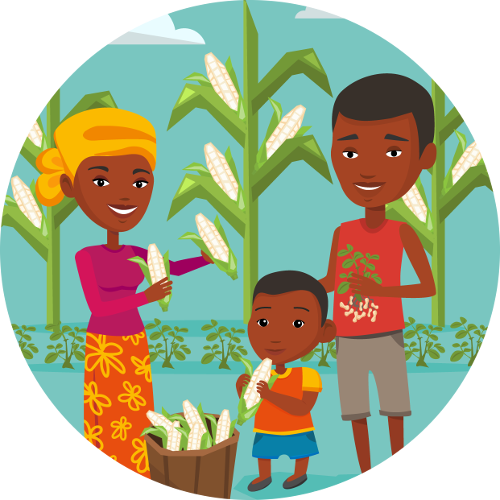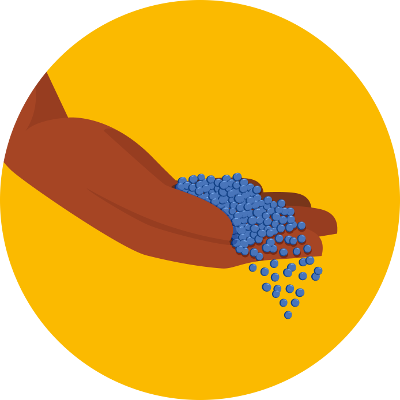 Not only does Aflasafe make food safe to eat, but it is also a safe and reliable product that does not endanger farmers, ecosystems, or economies. It is low-tech and easy to use, applied by simply spreading it about the field in handfuls.
Not only does Aflasafe make food safe to eat, but it is also a safe and reliable product that does not endanger farmers, ecosystems, or economies. It is low-tech and easy to use, applied by simply spreading it about the field in handfuls.
Friendly fungus that can’t turn bad
The active ingredient that makes Aflasafe work is friendly strains of the fungus Aspergillus flavus, the same species that makes aflatoxin. A combination of four strains is carefully tailored for each country, chosen from among thousands of different samples collected locally. These undergo extensive testing to find stable strains that not only do not produce the toxin, but are physically incapable of ever doing so as they do not have the right genes.
Those non-toxin-producing strains are never copyrighted in any way, but remain the genetic resources and property of the nations where they are found, where they can be used for maximum good.
Local heroes
 All the fungal strains that are used for Aflasafe are not only native, but also very common in the environment – so common that you could probably find all the key ingredients for your local Aflasafe in the soil under your feet, wherever you are in your country. Nothing from outside is ever introduced, so the balance of the ecosystem is not disturbed.
All the fungal strains that are used for Aflasafe are not only native, but also very common in the environment – so common that you could probably find all the key ingredients for your local Aflasafe in the soil under your feet, wherever you are in your country. Nothing from outside is ever introduced, so the balance of the ecosystem is not disturbed.
All the testing of Aflasafe has shown that, although as it flourishes it reduces the amount of aflatoxin and dangerous aflatoxin-producing fungi, it does not increase the overall amount of fungus in the environment or in the food crop, or the amount of other toxins produced by other fungal species. In the USA a similar product has been used on more than a million acres of farmland for over a decade with no negative impacts.
Reliable results, whatever the weather
All the friendly fungi used in Aflasafe are selected for being highly effective at reducing the amount of aflatoxin in food when tested out in the real world. They are successful strains, good at growing quickly and dominating whatever niche is available before the toxin-producers can get a foothold.
Using four different friendly strains – unlike in the US product, which only uses one – means having four different toxin fighters on our side. This makes Aflasafe more resilient and able to perform well whatever the conditions.
 During the development of Aflasafe there was some concern that the friendly fungi would not survive and thrive if drought hit after Aflasafe was applied. Application should ideally be timed to coincide with rainfall and moist soil, to help the fungi make a good start. However, if dry conditions do strike, the Aflasafe spores have been found to stay alive and take off later once they get a bit more water – and meanwhile a few Aflasafe grains protected by leaves usually have enough moisture to get the spores going.
During the development of Aflasafe there was some concern that the friendly fungi would not survive and thrive if drought hit after Aflasafe was applied. Application should ideally be timed to coincide with rainfall and moist soil, to help the fungi make a good start. However, if dry conditions do strike, the Aflasafe spores have been found to stay alive and take off later once they get a bit more water – and meanwhile a few Aflasafe grains protected by leaves usually have enough moisture to get the spores going.
Since Aflasafe uses native fungal strains, it is well adapted to whatever local conditions exist, including heat and drought. Each new country version of Aflasafe is tested over several years in varied regions of the country, and only strains that cut aflatoxin across the board are selected. The results show that Aflasafe cuts toxin levels by over 80% even in drought-prone areas.
Safe and sound with sorghum
 The friendly fungal spores travel into farmer’s fields on sorghum, which is their vehicle and first food as they get established. The grains are “killed” by roasting them before they are coated with the spores, which ensures that they cannot sprout or carry any other microbes with them.
The friendly fungal spores travel into farmer’s fields on sorghum, which is their vehicle and first food as they get established. The grains are “killed” by roasting them before they are coated with the spores, which ensures that they cannot sprout or carry any other microbes with them.
Despite its valuable role, the amount of sorghum used for Aflasafe is relatively tiny – just 10 kg/ha to achieve aflatoxin-safe food – so there is no significant impact on the amount of sorghum available for food, or on food security. In Nigeria, for example, the production of enough Aflasafe to treat one million hectares would only use 0.15% of national sorghum harvests. However, research is going on to test the use of other materials, such as waste cassava peel, to make the product even cheaper.
Quashing the risk of health risk
The risk assessments that have been carried out by various countries during the registration process classed Aflasafe as completely non-toxic. Since there is no overall increase in the amount of fungus in the environment when Aflasafe is used, it does not cause any increased risk of allergies and infection.
During manufacture, biosafety procedures minimise plant workers’ exposure to spores, keeping risk down even further regardless of Aflasafe’s benign nature. Farmers’ exposure when applying the product is also minimal, since the advance guard of friendly fungal spores is quite well stuck to the sorghum grain, and the real bloom of spores as these grow and spread is not until several days later.
Lasting benefits
 With cuts to aflatoxin levels approaching 100%, Aflasafe is an incredibly cost-effective way to deal with the problem of aflatoxin, particularly since it offers benefits that last. Without any treatment, aflatoxin-producing fungi can continue to infect and grow in food long after it is harvested, especially if it is kept in humid conditions. Aflasafe only requires a single application in the field, but it means that friendly fungi get in early and keep the dangerous toxin-producers out, protecting food through transport and storage all the way to your plate.
With cuts to aflatoxin levels approaching 100%, Aflasafe is an incredibly cost-effective way to deal with the problem of aflatoxin, particularly since it offers benefits that last. Without any treatment, aflatoxin-producing fungi can continue to infect and grow in food long after it is harvested, especially if it is kept in humid conditions. Aflasafe only requires a single application in the field, but it means that friendly fungi get in early and keep the dangerous toxin-producers out, protecting food through transport and storage all the way to your plate.
The positive effects even last across seasons: as the friendly fungi progressively displace the dangerous ones, each plot gets gradually safer over the years, as do its neighbours – although Aflasafe should still be applied each cropping season to get the full benefits.
Research publications
A selection of research relating to the safety and reliability of Aflasafe. For more, see our publications page.










